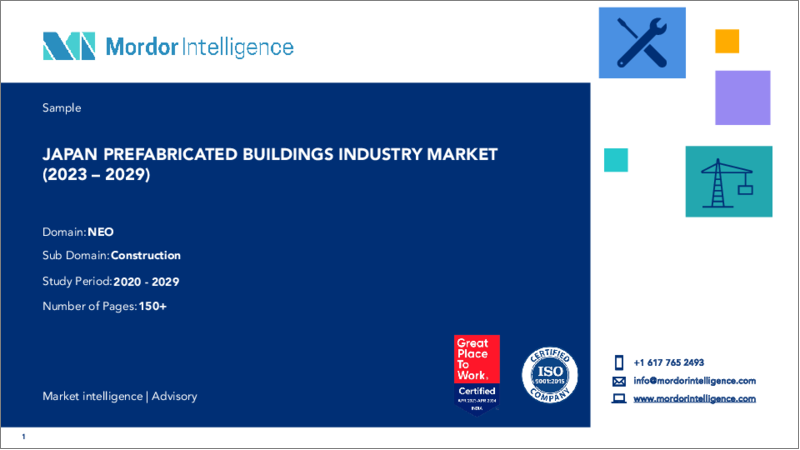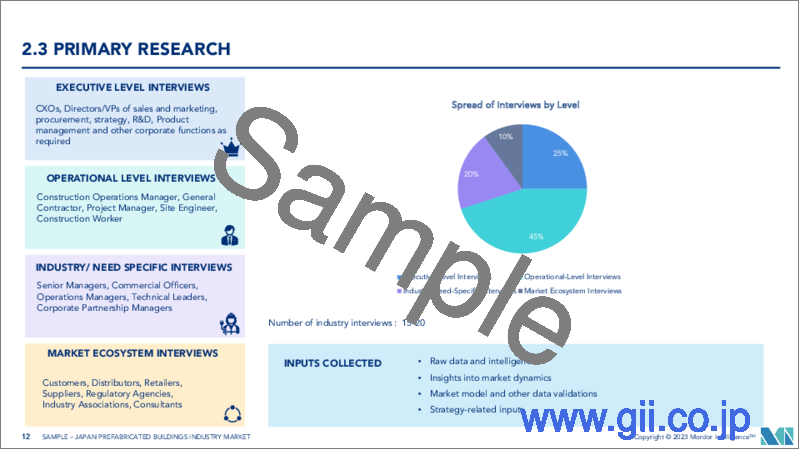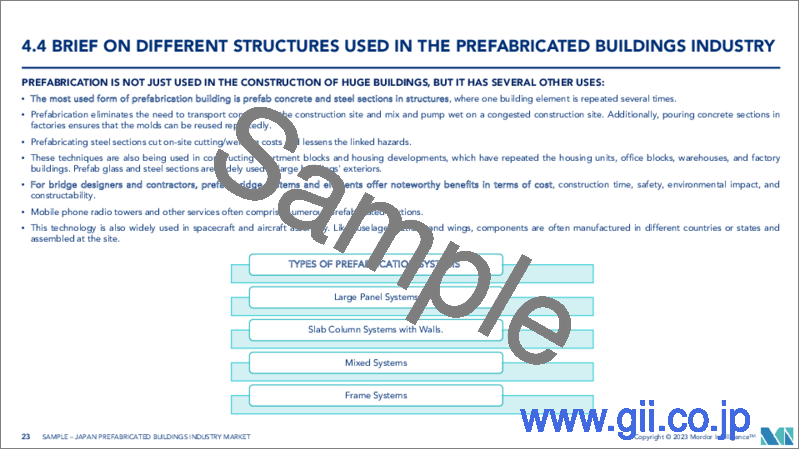|
|
市場調査レポート
商品コード
1406250
日本のプレハブ建築:市場シェア分析、産業動向と統計、2024年~2029年の成長予測Japan Prefabricated Buildings - Market Share Analysis, Industry Trends & Statistics, Growth Forecasts 2024 - 2029 |
||||||
カスタマイズ可能
適宜更新あり
|
|||||||
| 日本のプレハブ建築:市場シェア分析、産業動向と統計、2024年~2029年の成長予測 |
|
出版日: 2024年01月04日
発行: Mordor Intelligence
ページ情報: 英文 150 Pages
納期: 2~3営業日
|
- 全表示
- 概要
- 目次
日本のプレハブ建築市場規模は2024年に164億8,000万米ドルと推計され、2029年には222億8,000万米ドルに達すると予測され、予測期間中のCAGRは6%で成長すると予測されます。
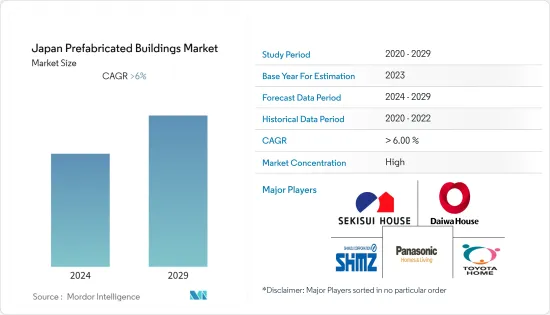
プレハブ住宅は、2022年の日本の住宅着工総数の約13.1%を占め、約11万2,500戸の新築住宅が着工されました。これは2021年から約0.8%の減少に相当します。
日本のプレハブ住宅開発は、非常に先進的な成果へと進化してきました。今日、日本のプレハブ住宅は、災害に強く、断熱性に優れ、オーダーメイドの設計という点で高水準に建設されています。
プレハブ建築は通常、50年から100年持つように設計されているが、プレハブ建築を利用する日本の家庭では、プレハブ建築を減価償却とみなしているため、30年ごとに家を建て替えています。プレハブ建築は多くの国で古くから存在していたが、近年ますます人気が高まっています。日本は他産業との相乗効果を利用してプレハブ市場を開拓してきました。検査は、一般的な建築基準法に従うのではなく、業界特有の訓練を受けた専門家によって行われます。
日本のプレハブ建築市場の動向
プレハブ住宅建設数の増加
日本では、住宅は長持ちするように建てられるのではなく、30年以上の寿命があります。誰かが亡くなると、その家(再販価値はない)は取り壊されて新しい家が建てられます。これは、日本の多くの郊外開発プロジェクトではスクラップ・アンド・ビルド政策として知られています。これは空間的にも時間的にも規定された慣習です。日本人は、規制を満たさず、耐用年数が近い、あるいは過ぎた仕様の古い家に住むことを良しとしないです。しかし、あることが彼らの考え方を変えつつあります。
建築物に含まれる具現化エネルギー(材料の生産、輸送、貯蔵に必要なエネルギー)は非常に大きいです。世界的に見ると、建設活動から排出されるCO2の量は、世界の約35%を占めています。
国土の13%はすでに無人であると推定され、2033年までにはこの数は約30%に増加すると予測されています。現在、国内には2,170万戸の空き家があります。国内では一般的に、空き家や無人の土地が問題となっています。こうした地域に住むわずかな人々は、税金で鉄道路線や病院、道路などの公共インフラを維持することができないです。空き家はプレハブ建築に建て替えられます。
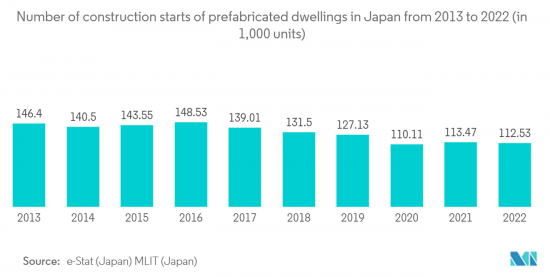
人口減少がプレハブ建築に与える影響
日本の人口は減少しており、2022年には日本人が前年比0.65%減の約80万人減少する一方、外国人人口は過去最高の約300万人に達すると研究者は予測しています。日本の人口減少を牽引したのは、高齢化と人口減少が進む中、国内に居住する外国人の数が減少したことです。政府によれば、2022年の日本の総人口は1億2541万人で、前年よりわずかに減少したが、日本に住所を持つ在留外国人は10.7%増加しました。日本の人口は初めて47都道府県すべてで減少しました。
日本の人口が減少を続け、人口動態が高齢化を続ける中、新築需要も減少していることは否定できないです。国内市場の新築需要が減少を続けるなか、各社は中国やその他のアジアの成長機会を活用したいと考えています。
日本のプレハブ建築産業の概要
本レポートは、日本のプレハブ建築産業で事業を展開する主要企業をカバーしています。市場競争は激しく、少数の企業が主要シェアを占めています。市場は断片化されており、予測期間中に成長すると予想されます。パナソニックホームズやトヨタホームといった大手プレハブメーカーが木造住宅事業に参入する一方、地元のパワービルダーや建設会社が力をつけています。
八街市オリジナルの一条工務店や積水が戸建住宅市場でシェアを伸ばしています。日本には積水、大和など世界最大級のプレハブ住宅メーカーがあります。日本の住宅メーカーは、海外進出によって事業を強化しています。例えば、パナソニックホームズ株式会社や大和ハウス工業株式会社などのデベロッパーは、戸建て住宅からコンドミニアム、建設労働者向けのプレハブ・フラットまで、海外のさまざまなニーズに応えようとしています。
その他の特典:
- エクセル形式の市場予測(ME)シート
- 3ヶ月間のアナリストサポート
目次
第1章 イントロダクション
- 調査の前提条件と市場の定義
- 調査範囲
第2章 調査手法
- 分析手法
- 調査フェーズ
第3章 エグゼクティブサマリー
第4章 市場洞察
- 現在の市場シナリオ
- 技術動向
- プレハブ建築産業のサプライチェーン/バリューチェーン分析に関する洞察
- プレハブ建築産業で使用されるさまざまな構造に関する概要
- プレハブ建築物産業のコスト構造分析
- 政府規制
- COVID19の影響
第5章 市場力学
- 促進要因
- インフラ・建設分野における政府の取り組みが業界を後押し
- 市場を牽引するプレキャストコンクリート技術のニーズ
- 抑制要因
- 輸送コストの上昇
- 機会
- グリーンビルディング構想の採用
- ポーターのファイブフォース分析
- 供給企業の交渉力
- 消費者/買い手の交渉力
- 新規参入業者の脅威
- 代替品の脅威
- 競争企業間の敵対関係の強さ
第6章 市場セグメンテーション
- 材料タイプ
- コンクリート
- ガラス
- 金属
- 木材
- その他の材料
- 用途
- 住宅用
- 商業用
- その他の用途(産業、施設、インフラストラクチャー)
第7章 競合情勢
- 企業プロファイル
- SEKISUI HOUSE
- DAIWA HOUSE GROUP
- PANASONIC HOMES CO
- TOYOTA HOUSING CORPORATION
- ORIENTHOUSE Co., Ltd
- KAWADA INDUSTRIES,INC.
- MISAWA HOMES
- SHIMIZU CORPORATION
- TODA CORPORATION
- ZENITAKA CORPORATION*
第8章 市場機会と今後の動向
第9章 付録
- マクロ経済指標(部門別GDP内訳、建設業の経済貢献など)
- 主な建設資材の生産、消費、輸出入統計

The Japan Prefabricated Buildings Market size is estimated at USD 16.48 billion in 2024 and is expected to reach USD 22.28 billion by 2029, growing at a CAGR of 6% during the forecast period.
Prefabricated housing accounted for approximately 13.1% of the total residential construction starts in Japan in 2022, with construction works initiated for nearly 112,5 thousand new housing units. This represents a decrease of approximately 0.8% from 2021.
Japan's prefab housing development has evolved into very advanced results. Today, Japanese prefab houses are built to high standards in terms of disaster resilience, thermal insulation, and bespoke designs.
Prefabricated buildings are typically designed to last 50 to 100 years, but Japanese families that use them rebuild their houses every 30 years because they view them as depreciating. Prefabricated construction has been around for a long time in many countries, but it has become increasingly popular in recent years. Japan has developed its prefabricated market by taking advantage of synergies with other industries. The inspections are carried out by industry-specific, trained professionals, rather than according to a general building code.
Japan Prefabricated Buildings Market Trends
Number of Prefabricated Housing Construction is Increasing
In Japan, houses are not built to last but rather have a lifespan of 30 years or more. When someone dies, their house (which has no resale value) will be torn down to build a new house. This is known as the scrap and build policy in many of Japan's suburban development projects. It is a practice that is defined in space as well as in time. Japanese people do not appreciate living in old homes that do not meet regulations and have specifications that are close to or over their useful life. But something is changing their mindset.
The amount of embodied energy in a building, which is the energy needed to produce, transport, and store materials, is very high. Globally, the amount of CO emitted from construction activities accounts for about 35% of the global.
An estimated 13% of the country is already uninhabited, and by 2033, this number is projected to rise to around 30%. There are currently 21.7 million vacant homes in the country. There is a general issue of abandoned houses and unoccupied land in the country. The few people who live in these areas are unable to maintain their public infrastructure, such as train lines, hospitals, or roads, with their taxes. The abandoned houses are then rebuilt into prefabricated buildings.

Shrinking Number in Population Might Impact construction of new Prefab buildings
The Population in Japan is shrinking, with researchers predicting the loss of about the number of Japanese nationals declined by nearly 800,000 in 2022, falling by 0.65% compared to the previous year, while the population of foreign residents reached a record high of nearly 3 million, to government data. The decline in the population of Japan was driven by a decline in the number of non-Japanese residing in the country, as the country continues to age and shrink. The total population of Japan was 125,41 million in 2022, down slightly from the year before, while foreign residents with addresses registered in Japan increased by 10.7%, according to the government. For the first time, the population of Japan declined in all 47 of its prefectures.
As Japan's population continues to shrink and the country's demographics continue to age, there's no denying that new construction demand is going down as well. As demand for new construction in the domestic market continues to decline, the companies want to capitalize on the growth opportunities in China and the rest of Asia.
Japan Prefabricated Buildings Industry Overview
The report covers the major players operating in the Japan Prefabricated Buildings Industry. The market is highly competitive with a few players occupying the major share. The market is fragmented, and the market is expected to grow during the forecast period. Major prefab manufacturers, such as Panasonic Homes and Toyota Home are entering the wooden housing business, while local power builders and construction companies are gaining power.
Hachimatsu City's original Ichijo construction company and Sekisui are increasing their shares in the detached housing market. The country has some of the largest prefabricated home manufacturers in the world, such as Sekisui, Daiwa, etc. The Japanese homebuilders are strengthening their businesses by expanding to overseas countries. For instance, developers, such as Panasonic Homes Co. and Daiwa House Industry Co. have been trying to meet a variety of overseas needs, from single homes to condominiums and prefabricated flats for construction workers.
Additional Benefits:
- The market estimate (ME) sheet in Excel format
- 3 months of analyst support
TABLE OF CONTENTS
1 INTRODUCTION
- 1.1 Study Assumptions and Market Definitions
- 1.2 Scope of the Study
2 RESEARCH METHODOLOGY
- 2.1 Analysis Methodology
- 2.2 Research Phases
3 EXECUTIVE SUMMARY
4 MARKET INSIGHTS
- 4.1 Current Market Scenario
- 4.2 Technological Trends
- 4.3 Insights on Supply Chain/Value Chain Analysis of the Prefabricated Buildings Industry
- 4.4 Brief on Different Structures Used in the Prefabricated Buildings Industry
- 4.5 Cost Structure Analysis of the Prefabricated Buildings Industry
- 4.6 Government Regulations
- 4.7 Impact of COVID 19
5 MARKET DYNAMICS
- 5.1 Drivers
- 5.1.1 Government Initiatives in the Infrastructure and Construction Sector to Boost the Industry
- 5.1.2 Need for Precast Concrete Technology Driving the Market
- 5.2 Restraints
- 5.2.1 Higher Transportation Cost
- 5.3 Opportunitites
- 5.3.1 Adoption of Green Building Concept
- 5.4 Porter's Five Forces Analysis
- 5.4.1 Bargaining Power of Suppliers
- 5.4.2 Bargaining Power of Consumers / Buyers
- 5.4.3 Threat of New Entrants
- 5.4.4 Threat of Substitute Products
- 5.4.5 Intensity of Competitive Rivalry
6 MARKET SEGMENTATION
- 6.1 Material Type
- 6.1.1 Concrete
- 6.1.2 Glass
- 6.1.3 Metal
- 6.1.4 Timber
- 6.1.5 Other Material Types
- 6.2 Application
- 6.2.1 Residential
- 6.2.2 Commercial
- 6.2.3 Other Applications ( Industrial, Institutional, and Infrastructure)
7 COMPETITIVE LANDSCAPE
- 7.1 Overview (Market Concentration and Major Players)
- 7.2 Company Profiles
- 7.2.1 SEKISUI HOUSE
- 7.2.2 DAIWA HOUSE GROUP
- 7.2.3 PANASONIC HOMES CO
- 7.2.4 TOYOTA HOUSING CORPORATION
- 7.2.5 ORIENTHOUSE Co., Ltd
- 7.2.6 KAWADA INDUSTRIES,INC.
- 7.2.7 MISAWA HOMES
- 7.2.8 SHIMIZU CORPORATION
- 7.2.9 TODA CORPORATION
- 7.2.10 ZENITAKA CORPORATION *
8 MARKET OPPORTUNITIES AND FUTURE TRENDS
9 APPENDIX
- 9.1 Marcroeconomic Indicators (GDP breakdown by sector, Contribution of construction to economy, etc.)
- 9.2 Key Production, Consumption,Exports & import statistics of construction Materials
